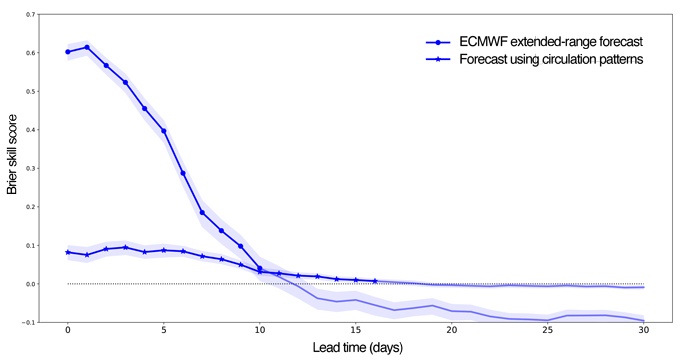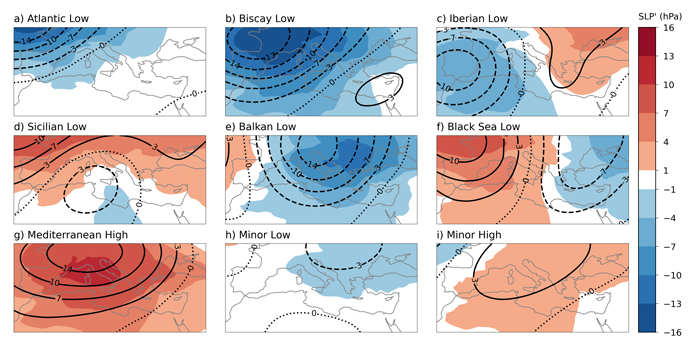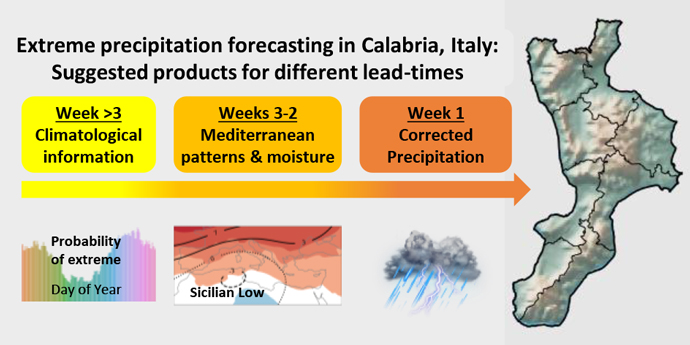

Emmanuel Rouges and Nikolaos Mastrantonas, ECMWF scientists, Evaluation Section, Forecast Department.
Sub-seasonal (also referred to as extended-range) prediction, looking about two weeks to one month ahead, can provide vital early warning of weather extremes and is a key area of research and operational interest. Improving forecasts of extreme events is also a key goal within ECMWF’s Strategy.
We are ECMWF scientists working on sub-seasonal prediction of extreme weather events in Europe leveraging pattern-based forecasting, as part of the EU-funded Climate Advanced Forecasting of sub-seasonal Extremes (CAFE) project. The four-year CAFE project is now drawing to a close and we share the main findings from our projects here.
Emmanuel’s project: Forecasting heatwaves at the sub-seasonal range
Heatwaves have become a growing concern in recent years in the context of climate change. The summer of 2022 is another worrying example with the symbolic threshold of 40°C being reached in the south of England.
The project I am involved in, together with Laura Ferranti (ECMWF) and Prof. Holger Kantz (Max Planck Institute for the Physics of Complex Systems), focuses on identifying the drivers of heatwaves over Europe and using those drivers to forecast heatwaves at the sub-seasonal range. The aim is to use large-scale atmospheric features, called circulation patterns, associated with heatwaves to forecast extreme warm temperatures. The idea being that forecast models can predict these large features at the sub-seasonal range more easily than surface parameters such as temperature.
The process started by clustering heatwave events based on their atmospheric circulation using k-means clustering (Michelangeli et al., 1995; Hannachi et al., 2017), to identify the main European heatwave types. Each type is characterised by a distinctive circulation pattern with a large anti-cyclone located over the heatwave region (Figure 1). When these circulation patterns persist (for five days or longer) they are key drivers of heatwaves and provide a potential source of predictability.

Figure 1: Five heatwave patterns represented as composites of daily mean 2-metre temperature (colour shading (K)) and geopotential height anomaly at 500hPa (contours: continuous lines showing positive anomalies and dashed lines showing negative anomalies).
To identify further sources of predictability at the sub-seasonal range, we investigated the role of soil moisture pre-conditioning and of tropical convection in the occurrence of heatwaves. Dry soil moisture conditions may have a direct physical link with heatwaves by reducing latent cooling and therefore further exacerbating heat extremes, but we found very little systematic link with heatwaves. Only southern regions and specific cases (e.g. the 2003 heatwave over western Europe) are linked with significantly reduced soil moisture content.
Tropical convection associated with the Boreal Summer Intra-Seasonal Oscillation (BSISO; Lee et al., 2013, Kiladis et al., 2014) has a less local effect, as it can be a source of Rossby wave trains propagating from the tropics to Europe. In our studies, we found a correlation between active phases of the BSISO and Russian heatwaves in particular. These heatwaves were linked with a reduced spread (reduced uncertainty) and improved accuracy of the forecast at lead times beyond ten days.
In the latest stages of the research, we assessed the accuracy of the ECMWF extended-range forecast and determined the potential gain from using circulation patterns as predictors of extreme warm temperatures. The circulation patterns are correlated with a high probability of extreme warm temperatures, significantly higher than the climatology (three to five times higher).
Using 20 years of forecast data we tested the skill of the pattern-based forecast. The results show that a pattern-based forecast has better skill beyond ten days than the regular forecast, essentially extending the forecast range of the ECMWF model by up to seven days (Figure 2).

Figure 2: Skill of extreme warm temperature forecasts (2-metre temperature over the 90th percentile) over the Scandinavian region measured using the Brier skill score. The line with circles represents the ECMWF extended-range forecast and the line with stars shows the forecast using circulation patterns, where their skill is higher than climatology (shown by the black line at zero).
Extending the forecast range is essential for early warning systems allowing decisions and mitigations to be taken/implemented earlier and reducing the impacts of heatwaves on the agricultural and energy sectors, for example, and protecting communities.
Nikos’ project: Forecasting extreme precipitation in the Mediterranean at the sub-seasonal range
The floods in Germany and nearby countries in 2021 provide an example of the devastating consequences of extreme precipitation events (EPEs) and highlight the need for better predictions of such events at longer lead times.
Over the past three years I have focused on extreme precipitation forecasting in the Mediterranean, looking mainly at sub-seasonal timescales and connections between localised extreme rainfall and large-scale atmospheric variability. The video below summarises the methodology used.
Initially we used empirical orthogonal function and subsequent K-means clustering to group the daily atmospheric variability into nine groups of distinct weather characteristics. These groups, referred to as “Mediterranean patterns”, indicate locations of high or low pressure over different parts of the domain (Figure 3). Our analysis showed that these patterns are in fact substantially related to extreme precipitation over the region, with conditional probabilities of EPEs over four times higher than their climatological probabilities for the preferential pattern for each location.

Figure 3. The nine Mediterranean patterns associated with extreme precipitation, based on atmospheric variability in the lower- and mid- troposphere (sea level pressure anomaly (coloured shading) and geopotential height anomaly at 500 hPa (contours)). The methodology for the derivation of the patterns is described in Mastrantonas et al. (2021).
As a next step we assessed the skill of ECMWF forecasts in predicting the patterns, and we demonstrated that the model provides skilful predictions up to 10 to 14 days ahead. In addition, using the forecasted patterns and their climatological connections with EPEs can improve EPE predictions for longer lead times and extend the forecasting horizon by about half a week, reaching a horizon of over seven days for most of the regions in the Mediterranean.
Finally, we proposed tools that can improve EPEs forecasting in Calabria in southern Italy, an area of complex topography that poses additional challenges in precipitation forecasting. In addition to the Mediterranean patterns, we used local precipitation and local moisture conditions as predictors for EPEs. The analysis demonstrated that different techniques are preferential for different lead times. In general, for up to seven to ten days lead time, it is preferential to use the forecasted precipitation for EPE predictions. This information, however, should be corrected given the connections between extremes in the modelled world (reanalysis) and extremes in reality (observational dataset). For longer lead times, up to 15 to 18 days ahead, the best skill can be obtained by considering the forecast Mediterranean patterns in combination with the forecast extremity state of the local moisture conditions.

Figure 4. Suggested techniques for extreme precipitation forecasting in Calabria, southern Italy.
The methodology can be extended to other parts of the Mediterranean (and the world), as well as other types of meteorological extremes. In an attempt to support such efforts by the research/operational community, we provide all the scripts of the relevant publications freely on GitHub and we are happy to give more information to interested users.
More on sub-seasonal forecasts
Our projects have produced some useful insights about heatwaves and extreme precipitation over Europe, and we have proposed tools that improve their predictability for longer lead times. This work is not independent but is part of the CAFE project, an EU-funded project with over ten partners in five countries. ECMWF is one of ten organisations hosting and recruiting researchers as part of the project.
Besides ourselves, there are ten more early-stage researchers working on topics regarding sub-seasonal extremes in this project. During the project two other CAFE scientists, Xinjia Hu and Niclas Rieger, had secondments at ECMWF working on El Niño Southern Oscillation (ENSO) and Madden-Julian Oscillation (MJO) prediction. Shraddha Gupta, who was co-supervised through ECMWF, also joined our facilities in Reading for a short period as a visiting scientist. Her work uses the theory of complex networks to explore the predictability of climate regime changes on the sub-seasonal scale.
In this blog we have covered only a small part of the outputs from the CAFE project. A policy-feedback document incorporating the results of all CAFE outputs will be compiled and disseminated in the coming weeks. More information about the project and many of its outputs are available on the CAFE project website.
Acknowledgements
We are grateful for contributions and comments from our colleagues, in particular: Florian Pappenberger (Director of Forecasts at ECMWF), Linus Magnusson and Laura Ferranti (ECMWF), and Alvaro Corral (CRM, Barcelona).
This work is part of the Climate Advanced Forecasting of sub-seasonal Extremes (CAFE) project. The project has received funding from the European Union's Horizon 2020 research and innovation programme under the Marie Skłodowska-Curie grant agreement No 813844.
Follow Emmanuel and Nikos on Twitter!
Banner image credit: pigphoto/iStock/Getty Images Plus
